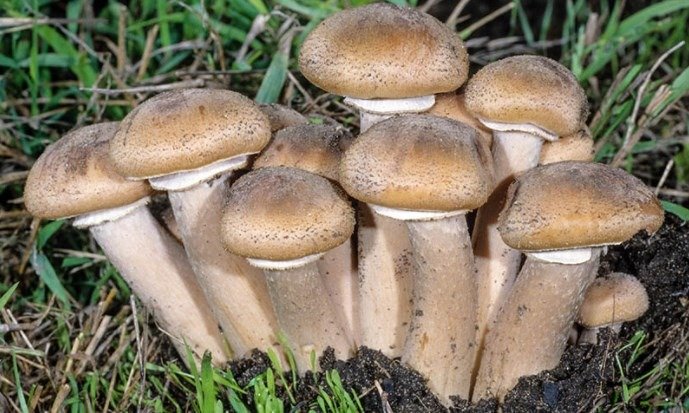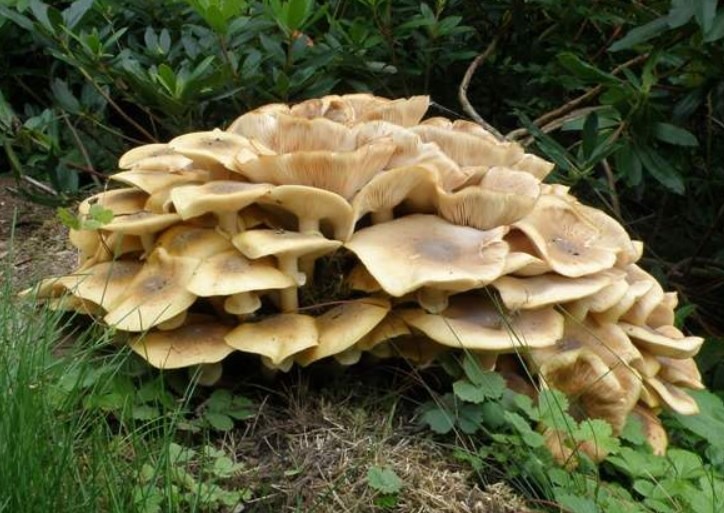The Armillaria mellea is a fungus that occurs in forms that vary greatly in relation to the habitat and the plants that host it and also the age and maturity of the fungus. The nail fungus is a small lignicola species that develops in big tufts and that can also reach interesting dimensions.

Other names of Armillaria Mellea
The Armillaria mellea is also known in Italian by the following names: Armillariella mellea, agaric honey-colored or good family, nail mushroom, cavatello mushroom, Vernetto mushroom. The most common Italian name is “fungo chiodino”.
It is called the nail fungus because in the first stage of its development it looks just like a small nail surmounted by a head.
The term “Mellea” refers to the Latin name for honey intended as “honey color” and not intended for the taste and smell of honey.

Description
Cap
The cap of the Armillaria mellea ranges from 3 to 20 cm in diameter (sometimes 25). In the young phase of the fungus it is spherical, then it becomes convex and then flat with most of the times the upper intermediate part depressed like a wide circular groove.
The colour and the tonalities of the cap of the Armillaria mellea are very variable and depend, in part, on the plant on which the fungus develops. For example, on poplars the nail is yellow as well as on mulberries. On the contrary, on the Oaks it is of brownish colour. On the elder it is grey-black and on the conifers it becomes reddish brown.
Gills
The gills of Armillaria mellea are not very thick. However, they are different from each other and arched in the very old specimens. They range in colour from white to creamy yellow to rust stained. It may happen that in the dark the gills of the Armillaria mellea are slightly luminescent, emitting a dim greenish light.
Cuticle
The cuticle of the mushroom nail becomes shiny in wet weather with dry weather instead becomes opaque. It is covered by numerous brown scales, curved that thicken a lot towards the central part of the cap, that is towards the apex. The scales become more rarefied as you approach the edge. Mature specimens may also be free of these scales.
Stipe
The stipe of the Armillaria mellea is cylindrical and very elongated. It has an elastic but hard and fibrous consistency at the same time. It can measure from 6 to 15 cm in height. The stipe, if the fungus has grown up in a small family, is crushed in the lower part, where it is in contact with the other specimens.
Ring
The ring in the young fungi adheres to the cap forming a sort of curtain. It is placed on the top of the stipe and is membranous with white or yellow colours.
Flesh
The flesh of Armillaria mellea is elastic in the cap and woody in the stipe. It smells like wet hay. The taste, on the other hand, is bitterish or sweet, depending on the variety.

Habitat of Armillaria mellea
Armillaria mellea is a species of fungus very common throughout Europe. It is found at all altitudes and has the characteristic of being able to live both as a fungus saprophyte and as a fungus parasite.
If it develops as a saprophyte saprophyte fungus, its mycelium develops over woody debris and then widens until it finds on its way a vulnerable tree that is attacked. From then on the fungus begins to live as a parasite of the tree.
It is therefore a danger to some types of trees in poor health. For example, trees that have been badly damaged or already sick or damaged by the weather or the wind. Willows in particular suffer greatly from the fungus Armillaria mellea
However, it may also happen that the development of the Armillaria mellea fungus starts as a parasite. In this case it starts with the wounds of a living plant or under its bark. After a few years the parasite kills the plant and continues to feed on its wood like a saprophyte until it completely decomposes the plant.
It can be found both above the trunks of diseased or rotten trees and also on fallen broadleaf and conifer stumps or fragments of wood on the ground. It also grows on the plain in the middle of the bramble bushes or along the canals.
Growth period
The Armillaria mellea develops from the beginning of autumn but can also be found in summer if there have been sudden drops in temperature. The fungus, however, is among the most common and develops both in very large groups and also individually.
Similar species
The Armillaria mellea can be confused with other very similar species of fungi: for instance the Galerina mutabilis and also the Armillaria tabescens which are, however, two edible fungi. A poisonous fungus, on the contrary, is the Hypholoma fasciculare, which has a very bitter taste. It may also be confused with other fungi growing in large families on the stumps. For example, it can be confused with the velvety agaric that we have already talked about in another article and that you should read, you can find it here: flammulina velutipes.
Variability of Armillaria mellea
As we have already said, the Armillaria mellea mushroom is one of the most variable mushrooms known. Although its size and shape depend mainly on the level of ripeness of the fungus, the colour of the nail depends on the host plant it feeds on or on the type of dead wood on which it has developed.
For example, on beech wood the color reddish brown while on chestnut wood is dark brown, on firs are small brown cuttlefish with a few specimens for each head. On mulberry wood they are honey-yellow and on poplar or elm wood they are tall and slender, brown in colour and very caespitose. On hazelnut wood they have a large cinnamon-coloured hat and on linden wood they are light to pale beige.
Collection of the fungus Armillaria mellea
When picking Armillaria mellea mushrooms you need to have a minimum of attention to avoid confusing it with some toxic species. Obviously not all mushrooms that grow on wood in large families are nail mushrooms. Some may be poplars or other edible species. However, there are some that are quite dangerous, so it is always advisable to keep an eye on the colour of the gills, the presence of the ring and the scales above the cap.
Cultivation of Armillaria mellea mushrooms
Armillaria mellea is a species which is also suitable for cultivation. It is sold in several countries and the cultivation methods are those suggested for the species of Pleuroti, such as one of the best and most cultivable mushrooms that you can discover on this page: the Pleurotus ostreatus.
Recipes with the fungus armillaria mellea
The armillaria mellea is also famous because usually you really collect baskets and bags full of them. This is because it is a fungus that is found in great abundance, provided that the conditions are optimal.
The best specimens to collect for gastronomic purposes are the very young ones, of which the stipe, which is tasteless and indigestible, is completely or largely eliminated. Usually the armillaria mellea mushroom is also boiled before being cooked because otherwise the armillaria mellea could also be slightly toxic for some particularly sensitive individuals.
Do not eat Armillaria mellea raw but boil for at least 5 minutes and then throw away the cooking water and the woody stipe of the mushroom.
Armillaria mellea mushroom sauce
An excellent preparation of the Armillaria mellea mushroom is obtained with a good stew, with garlic and parsley, oil, meat broth, tomato and chilli pepper.
The mushroom sauce armillaria mellea will be great for seasoning spaghetti. They are also delicious sautéed with butter and oil. They are excellent for soups and wet dishes.
IDENTITY CARD:
CUP COLOR: yellowish
RANGE HEIGHT: 5-20 cm
RANGE COLOUR: brownish
LAMELS: whitish
FLESH: White
SMELL: fruity
TASTE: bitterish
SPORES: white
HABITAT: Hardwood
Did you find what you were looking for? See also here:
- Ganoderma Lucidum
- Armillaria Mellea
- Amanita Caesarea
- Agaricus Bisporus
- Amanita Phalloides
- Coriolus Versicolor
- Flammulin Velutipes
- Marasmius Oreades
- Pleurotus Ostreatus
- Agaricus Campestris
- Macrolepiota procera